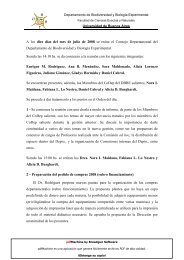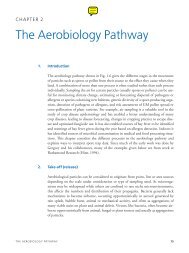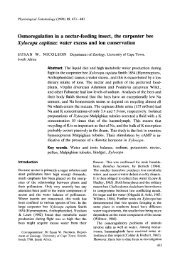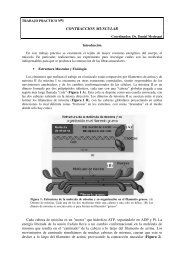Role of WUSCHEL in Regulating Stem Cell Fate in the Arabidopsis Shoot Meristem
Role of WUSCHEL in Regulating Stem Cell Fate in the Arabidopsis Shoot Meristem
Role of WUSCHEL in Regulating Stem Cell Fate in the Arabidopsis Shoot Meristem
Create successful ePaper yourself
Turn your PDF publications into a flip-book with our unique Google optimized e-Paper software.
<strong>Role</strong> <strong>of</strong> <strong>WUSCHEL</strong> <strong>in</strong> <strong>Shoot</strong> and Floral <strong>Meristem</strong>s<br />
807<br />
The WUS Gene Encodes a Homeodoma<strong>in</strong> Prote<strong>in</strong> <strong>the</strong> loss <strong>of</strong> about one-third <strong>of</strong> <strong>the</strong> prote<strong>in</strong>, <strong>in</strong>clud<strong>in</strong>g <strong>the</strong><br />
The putative transcription start <strong>of</strong> <strong>the</strong> WUS gene was putative transactivation doma<strong>in</strong>. The weak wus-3 allele<br />
determ<strong>in</strong>ed by 5�-RACE. We analyzed <strong>the</strong> genomic se- conta<strong>in</strong>s a prol<strong>in</strong>e to leuc<strong>in</strong>e missense mutation <strong>in</strong> <strong>the</strong><br />
quence upstream <strong>of</strong> <strong>the</strong> WUS gene and identified a TATA<br />
box, a CCAAT box, and a GC box at 35 bp, 56 bp, and<br />
N-term<strong>in</strong>al part <strong>of</strong> <strong>the</strong> homeodoma<strong>in</strong>.<br />
80 bp upstream <strong>of</strong> <strong>the</strong> transcription start, respectively<br />
(data not shown). A putative polyadenylation signal (Wu<br />
et al., 1995) was identified 20 bp upstream <strong>of</strong> <strong>the</strong> poly(A)<br />
tail (data not shown). A comparison <strong>of</strong> genomic and<br />
cDNA sequences revealed <strong>the</strong> presence <strong>of</strong> two <strong>in</strong>trons<br />
with a length <strong>of</strong> 566 bp and 90 bp, respectively (Figure<br />
2C). The WUS gene encodes a conceptual prote<strong>in</strong> <strong>of</strong><br />
291 am<strong>in</strong>o acids, and sequence comparison revealed<br />
two putative functional doma<strong>in</strong>s (Figure 2C). The region<br />
between am<strong>in</strong>o acid residues 33–98 shows similarity to<br />
homeodoma<strong>in</strong>s (see below), and <strong>the</strong> region between<br />
<strong>Cell</strong>ular Localization <strong>of</strong> <strong>the</strong> WUS Prote<strong>in</strong><br />
In order to study <strong>the</strong> subcellular localization <strong>of</strong> <strong>the</strong> WUS<br />
prote<strong>in</strong>, we used a translational fusion between WUS<br />
and <strong>the</strong> Glucuronidase (GUS) reporter gene <strong>in</strong> transient<br />
expression assays (Varagona et al., 1992). Figure 3 shows<br />
that WUS targeted most GUS activity <strong>in</strong>to <strong>the</strong> nucleus<br />
<strong>of</strong> onion epidermis cells. The nuclear localization activity<br />
<strong>of</strong> WUS is consistent with its proposed role as a tran-<br />
scriptional regulator.<br />
residues 234–241 conta<strong>in</strong>s a cluster <strong>of</strong> acidic am<strong>in</strong>o acid WUS Expression dur<strong>in</strong>g Embryogenesis<br />
residues. Computer analysis predicted that <strong>the</strong> acidic Phenotypic analyses had suggested that WUS is re-<br />
cluster can form an amphipathic � helix, similar to known quired for pluripotent cell fate dur<strong>in</strong>g embryonic shoot<br />
transactivation doma<strong>in</strong>s <strong>of</strong> transcriptional regulators meristem development (Laux et al., 1996). To test this<br />
(Ptashne, 1988).<br />
hypo<strong>the</strong>sis, we analyzed WUS mRNA expression dur<strong>in</strong>g<br />
embryogenesis. Due to an <strong>in</strong>variant cell division pattern<br />
WUS Represents a Novel Subtype <strong>of</strong> <strong>the</strong><br />
Homeodoma<strong>in</strong> Prote<strong>in</strong> Family<br />
Homeodoma<strong>in</strong> prote<strong>in</strong>s have been identified <strong>in</strong> many<br />
organisms and generally appear to be <strong>in</strong>volved <strong>in</strong> devel-<br />
opmental or cell type regulation. The characteristic ho-<br />
meodoma<strong>in</strong> is a conserved prote<strong>in</strong> doma<strong>in</strong> <strong>of</strong> about 60<br />
am<strong>in</strong>o acids that functions <strong>in</strong> sequence-specific DNA<br />
b<strong>in</strong>d<strong>in</strong>g. The hallmarks are a helix-loop-helix-turn-helix<br />
structure and 12 highly conserved am<strong>in</strong>o acid residues<br />
(Gehr<strong>in</strong>g et al., 1990; Laughon, 1991). The WUS homeo-<br />
doma<strong>in</strong> has all <strong>of</strong> <strong>the</strong>se properties and was found to be<br />
about 30% identical to and 45%–50% similar to several<br />
homeodoma<strong>in</strong> sequences from plants, animals, and yeast<br />
(Figure 2D). To determ<strong>in</strong>e <strong>the</strong> relationship <strong>of</strong> WUS to<br />
o<strong>the</strong>r homeodoma<strong>in</strong> prote<strong>in</strong>s, we performed a similarity<br />
analysis us<strong>in</strong>g a heuristic tree-build<strong>in</strong>g program. This<br />
analysis revealed that <strong>the</strong> WUS homeodoma<strong>in</strong> cannot<br />
be significantly grouped toge<strong>the</strong>r with any o<strong>the</strong>r homeodoma<strong>in</strong><br />
(data not shown) and <strong>the</strong>refore represents a<br />
novel branch on <strong>the</strong> homeodoma<strong>in</strong> prote<strong>in</strong> tree.<br />
<strong>in</strong> <strong>in</strong>itial stages <strong>of</strong> <strong>Arabidopsis</strong> embryo development,<br />
morphological regions <strong>of</strong> <strong>the</strong> seedl<strong>in</strong>g can be traced<br />
back to cells <strong>in</strong> <strong>the</strong> early embryo (Mansfield and Briarty,<br />
1991; Jürgens and Mayer, 1994). The eight-cell embryo<br />
consists <strong>of</strong> an apical region <strong>of</strong> four cells, which will form<br />
<strong>the</strong> shoot meristem and most <strong>of</strong> <strong>the</strong> cotyledons, and a<br />
basal region <strong>of</strong> four cells, which will form <strong>the</strong> hypocotyl<br />
and most <strong>of</strong> <strong>the</strong> root. Up to <strong>the</strong> eight-cell embryo stage,<br />
no WUS expression was detected (Figure 4A).<br />
Each <strong>of</strong> <strong>the</strong> eight embryo cells divides pericl<strong>in</strong>ally to<br />
give an <strong>in</strong>ner cell and an outer protoderm cell. This was<br />
<strong>the</strong> earliest stage at which WUS mRNA was detected.<br />
It was conf<strong>in</strong>ed to <strong>the</strong> four <strong>in</strong>ner cells <strong>of</strong> <strong>the</strong> apical region<br />
(Figure 4B). Each <strong>of</strong> <strong>the</strong>se <strong>in</strong>ner cells <strong>the</strong>n divides longitud<strong>in</strong>ally,<br />
giv<strong>in</strong>g rise to a central and a peripheral daugh-<br />
ter. WUS mRNA was only detected <strong>in</strong> central daughter<br />
cells but was absent from peripheral daughters (Figures<br />
4C and 4D).<br />
The transition-stage embryo consists <strong>of</strong> about 100<br />
cells and is characterized by <strong>the</strong> outgrowth <strong>of</strong> cotyledon-<br />
ary primordia on each side <strong>of</strong> <strong>the</strong> presumptive shoot<br />
meristem region (Figure 4E). At this stage, WUS mRNA<br />
Mutations Disrupt<strong>in</strong>g <strong>the</strong> WUS Gene<br />
was detected <strong>in</strong> two subepidermal cells <strong>in</strong> <strong>the</strong> center <strong>of</strong><br />
Based on <strong>the</strong> average number <strong>of</strong> central stamens <strong>the</strong> apex (Figure 4E). Serial sections suggested that <strong>the</strong><br />
formed <strong>in</strong> mutant flowers, we classified <strong>the</strong> three mutant WUS expression doma<strong>in</strong> was only one cell deep (data<br />
alleles wus-1, wus-2, and wus-4 as strong (about one not shown).<br />
stamen per flower) and wus-3 as a weak allele (about At <strong>the</strong> heart stage, <strong>the</strong> basic body organization, com-<br />
three stamens per flower). The WUS gene was amplified pris<strong>in</strong>g cotyledonary primordia, shoot meristem primorand<br />
sequenced from genomic DNA <strong>of</strong> homozygous wus dium, hypocotyl primordium, and root pole, is histologi-<br />
mutants. In each allele a s<strong>in</strong>gle po<strong>in</strong>t mutation relative cally recognizable. The subepidermal cells with<strong>in</strong> <strong>the</strong><br />
to wild type was detected (Figure 2C). The mutations shoot meristem region have divided transversely, giv<strong>in</strong>g<br />
<strong>in</strong> <strong>the</strong> three strong wus alleles presumably lead to a rise to upper (L2) and lower (L3) daughter cells. WUS<br />
premature translational stop. In wus-4, a TAA stop co- mRNA was restricted to <strong>the</strong> L3 daughter cells but was<br />
don results <strong>in</strong> a translational stop after 44 am<strong>in</strong>o acid absent from <strong>the</strong> L2 daughters (Figure 4F). Longitud<strong>in</strong>al<br />
residues. In wus-1, <strong>the</strong> 5�-exon-<strong>in</strong>tron boundary <strong>of</strong> <strong>in</strong>tron sections perpendicular to <strong>the</strong> plane <strong>of</strong> <strong>the</strong> cotyledons<br />
2 is changed from GG to GA, replac<strong>in</strong>g a G that is highly revealed that <strong>the</strong> WUS expression doma<strong>in</strong> spans only<br />
conserved at plant gene splice sites (Brown, 1996). The one cell <strong>in</strong> depth (Figure 4G). Until this stage, we have<br />
failure to remove <strong>in</strong>tron 2 results <strong>in</strong> a translational stop not found a s<strong>in</strong>gle case (n � 60) <strong>in</strong> which after a cell<br />
after a few codons with<strong>in</strong> <strong>the</strong> <strong>in</strong>tron (data not shown). division both daughter cells conta<strong>in</strong>ed WUS mRNA, <strong>in</strong>di-<br />
wus-2 conta<strong>in</strong>s a TAG stop codon at am<strong>in</strong>o acid position cat<strong>in</strong>g that asymmetric WUS mRNA distribution was<br />
209. In wus-1 and wus-2, a translational stop results <strong>in</strong><br />
established dur<strong>in</strong>g or rapidly after cell division.



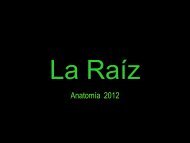
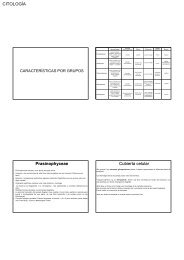


![Estructuras secretoras internas [4.64 MB]](https://img.yumpu.com/14294979/1/190x143/estructuras-secretoras-internas-464-mb.jpg?quality=85)
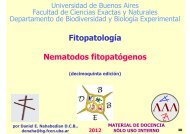
![anatomía y exomorfología [7.14 MB]](https://img.yumpu.com/12744163/1/190x143/anatomia-y-exomorfologia-714-mb.jpg?quality=85)
